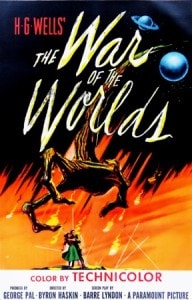“If they’re mortal, they must have mortal weaknesses. They’ll be stopped, somehow.”——Gene Barry
The original version of The War of the Worlds was a product of the horror/science fiction films of the 1950s following World War II and expressing latent fears of the hydrogen bomb and Russian invasions. Although the genre has never gone out of style since, the ’50s inspired perhaps the greatest period of voyages to other planets, monsters from outer space, mutant insects and robots gone amuck. Not many masterpieces among the lot, but the films were often quirky, sometimes original and frequently absorbing. When not comically amateurish, the special effects were occasionally ground-breaking, startling in their day, though crude by today’s computer-generated standards.
Even the Japanese got in on Hollywood’s act—“monster” men in rubber suits in such “epics” as Godzilla and Rodan, which often provided more laughs than anything else. The British, a decade later, followed with the more sophisticated The Day the Earth Caught Fire and First Men In the Moon, an intelligent version, comic elements aside, of the H. G. Wells novel, with Ray Harryhausen stop-action Moon Men and a giant caterpillar.
The 1953 movie version of Wells’ 1898 novel The War of the Worlds stars Gene Barry, Ann Robinson and Les Tremayne, with small parts—sometimes only a single line, if that—for Jack Kruschen, Henry Brandon, Robert Cornthwaite and Vernon Rich. Some famous people have non-speaking appearances: actress Carolyn Jones and Fred Zendar, diving master and technical adviser on a number of “watery” films. Even the film’s producer George Pal is seen as a bum listening to a radio. Pal is responsible for a few other similar films—When Worlds Collide, Destination Moon, Atlantic, Conquest of Space and The Time Machine, based on another Wells novel.
The War of the Worlds is tightly directed by Byron Haskin, who also has to his credit such companion horror/science fiction flicks as The Naked Jungle, Conquest of Space, From the Earth to the Moon and Robinson Crusoe on Mars. He often collaborated with Pal.
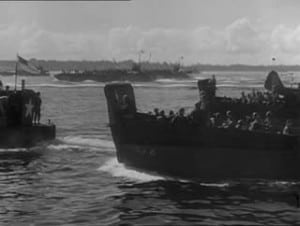 Unusual for its time, the film begins with a brief newsreel, chronicling the terrors of World War II and the conflict as a harbinger of more devastation from “super science.” The somewhat overwrought narrator (Paul Frees) gives way to the flashing letters of the credits and Leith Stevens’ main title music.
Unusual for its time, the film begins with a brief newsreel, chronicling the terrors of World War II and the conflict as a harbinger of more devastation from “super science.” The somewhat overwrought narrator (Paul Frees) gives way to the flashing letters of the credits and Leith Stevens’ main title music.
More straightforward and reserved comes Sir Cedric Hardwicke’s introductory narration, beginning with a close approximation of the opening line of Wells’ novel, updated from its publication in the last years of the nineteenth century: “No one would have believed in the middle of the twentieth century that human affairs were being watched keenly and closely by intelligences greater than man’s . . . ”
Hardwicke outlines why these Martians, looking for a new home away from their dying planet, have eliminated all but Earth, though the narration omits Venus. The sequences of accompanying paintings by Chesley Bonestell, practically the father of science fiction art, are as vivid and dramatic as Stevens’ music is appropriately mysterious and ominous. But what’s this—cumulus clouds hovering in space around Saturn?!
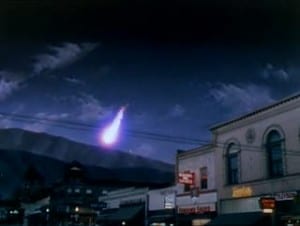 As the narration ends, a meteorite-like sphere streaks across the sky and crashes near a small California town. A trio of scientists from the Manhattan Project just happen to be fishing nearby and are notified by the local police. In a unique way of introducing the top-billed star, two of the fishermen comment first before Dr. Clayton Forrester (Barry) has a line, even then underplayed.
As the narration ends, a meteorite-like sphere streaks across the sky and crashes near a small California town. A trio of scientists from the Manhattan Project just happen to be fishing nearby and are notified by the local police. In a unique way of introducing the top-billed star, two of the fishermen comment first before Dr. Clayton Forrester (Barry) has a line, even then underplayed.
Among the media and curiosity seekers at the site of the gigantic boulder-like object is Sylvia Van Buren (Robinson), who has been a distant admirer of Forrester since college and doesn’t recognize him until he introduces himself. A policeman’s Geiger counter indicates radioactivity from the object and he comments that perhaps people should be cleared away. Forrester replies casually that it might be a good idea. The dangers of radiation are treated most nonchalantly, and it appears that no one leaves the area.
That evening, the cylinder is unguarded except for three men, who approach it when they hear a strange sound and see a manhole-like cover noisily unscrewing, then sliding to the ground. From out of the cylinder’s glowing interior—well captured with a slow, tightening shot by cinematographer George Barnes and Stevens’ needle-pricking, tense music—emerges a mechanical, cobra-like extension, with a pulsating red light in its oval head, all the while emitting nervous beeps. Truly, a frightening moment for a film of its day. As the men come closer, waving a white flag, welcoming this “thing” to California and already thinking this encounter will make them famous, the snake head emits a flashing heat ray which vaporizes them and damages nearby electrical lines.
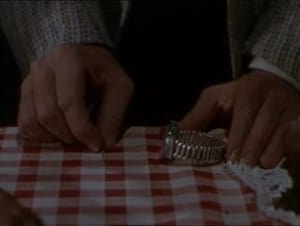 At a local dance, the lights go out, everyone’s watches stop, an old man’s hearing aid fails and a compass, which a man conveniently has in his pocket, points not north but toward the space object. The policemen’s cars, walkie-talkies and sirens are strangely exempt from this strong magnetic field, another of the numerous technical errors in the film.
At a local dance, the lights go out, everyone’s watches stop, an old man’s hearing aid fails and a compass, which a man conveniently has in his pocket, points not north but toward the space object. The policemen’s cars, walkie-talkies and sirens are strangely exempt from this strong magnetic field, another of the numerous technical errors in the film.
As more of these strange “meteorite” objects crash around the world and near the town, the Marines surround the one sphere, which by now has given birth to three hovering, manta ray-like machines, the previously unseen body below the snake-like appendage. (It isn’t shown how they emerge from the cylinder, clearly not from the much-too-small “manhole” hatch.)
Sylvia’s uncle, a pastor (Lewis Martin), approaches the invaders, holding aloft his Bible and reciting Psalm XXIII. “If they’re more advanced than us,” he had said, “they should be nearer the creator for that reason.” He is vaporized but not until he had finished the Psalm. These are the first of numerous religious elements in the film, contrary to the novel. Wells had a general disdain for the clergy, much like fellow countryman Winston Churchill, and was himself an agnostic; Christianity, or any of the other religions, does “not work for me.”
As the machines attack and Forrester dives for cover, the Marines open fire with all their artillery—and later bombers drop their loads. The alien machines, with their heat rays and dome-like protective shields, are “untouched” as General Mann (Tremayne) remarks.
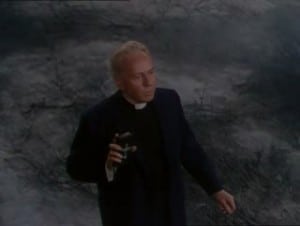 Forrester and Sylvia escape in a small military plane, but soon crash and take refuge in a deserted farmhouse. Although they are surrounded by Martian spheres, for the longest time a domestic scene ensues. Forrester sits down to poached eggs with tie in place and his coat still buttoned. He learns she comes from a large family and announces he has no family at all.
Forrester and Sylvia escape in a small military plane, but soon crash and take refuge in a deserted farmhouse. Although they are surrounded by Martian spheres, for the longest time a domestic scene ensues. Forrester sits down to poached eggs with tie in place and his coat still buttoned. He learns she comes from a large family and announces he has no family at all.
Their domesticity is interrupted, first, by a tricolored electronic eye, which Forrester hacks to pieces, and then by a Martian hand on Sylvia’s shoulder, which prompts the loudest scream from any movie of the ’50s. As Forrester fights off the creature—the viewer has little more than a fleeting glimpse—the Martian’s blood spatters on her scarf.
The two earthlings escape the farmhouse just before the gathering machines destroy it. In an interesting discrepancy, where before the cylinders had to cool for a day or so before releasing their machines, here, around the farmhouse, the machines are out of the cylinders soon after they have landed.
Back in a lab, it’s determined from the sample of blood on Sylvia’s scarf that the creatures are physically primitive and anemic.
 The U.S. Air Force launches one variety of a so-called “Flying Wing” and drops an atom bomb on the invaders. (The Northrop YB-49s, forerunners of the Stealth Bomber, had long since proved impractical, having crashed or been retired from service, and the shot on screen of one in flight came from archival footage.) Even this more deadly bomb has no effect on the Martians, and, again, the resultant radiation seems to bother no one.
The U.S. Air Force launches one variety of a so-called “Flying Wing” and drops an atom bomb on the invaders. (The Northrop YB-49s, forerunners of the Stealth Bomber, had long since proved impractical, having crashed or been retired from service, and the shot on screen of one in flight came from archival footage.) Even this more deadly bomb has no effect on the Martians, and, again, the resultant radiation seems to bother no one.
It’s predicted that the Martians will conquer the Earth is six days, and, in keeping with the religious overtones here, we’re reminded that this is the same time the Bible asserts it took God to create the Earth. Sylvia and Forrester are separated in the confusion as Los Angeles, now under attack, is evacuated. The desolate downtown streets are reminiscent of those in a number of films, especially On the Beach. After Forrester’s laboratory truck is seized by a mob, he searches for Sylvia. He finds her in a church where the desperate evacuees have gathered to pray and prepare for the end.
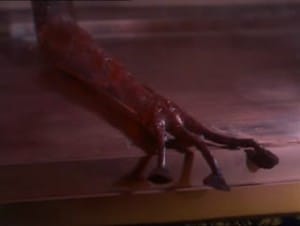 These prayers are answered, at least in the mind of screenwriter Barré Lyndon, for all over the world the manta ray-like machines are crashing. From the underside of one that collapses near the church, a hatch opens and out of the lingering vapors the thin, leathery arm of a Martian inches across the hatch lid, its disc-like finger tips finally stilled. With no thought of possible contamination, either from outer space or from this creature, Forrester feels the being’s pulse and pronounces it dead.
These prayers are answered, at least in the mind of screenwriter Barré Lyndon, for all over the world the manta ray-like machines are crashing. From the underside of one that collapses near the church, a hatch opens and out of the lingering vapors the thin, leathery arm of a Martian inches across the hatch lid, its disc-like finger tips finally stilled. With no thought of possible contamination, either from outer space or from this creature, Forrester feels the being’s pulse and pronounces it dead.
“The Martians had no resistance to the bacteria in our atmosphere . . . ,” runs Hardwicke’s closing narration. “All over the world, their machines began to stop and fall. After all that men could do had failed, the Martians were destroyed and humanity was saved by the littlest things”—and here most contrary to Wells and his novel—“which God in His wisdom, had put upon this Earth.”
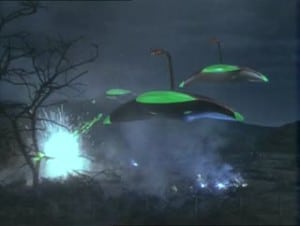 So effective is the film in its story line, its agile pacing and its brilliant special effects, that the weaknesses in the acting, the script and scientific fact hardly seem to matter. Even for the individuals who have read the novel, it probably doesn’t matter that the Martian machines, and the Martians themselves for that matter, are nothing like Wells’ descriptions. Gene Barry is overly stoic and Ann Robinson largely unresponsive as a love interest, though, after all, the film was not meant to be a love story.
So effective is the film in its story line, its agile pacing and its brilliant special effects, that the weaknesses in the acting, the script and scientific fact hardly seem to matter. Even for the individuals who have read the novel, it probably doesn’t matter that the Martian machines, and the Martians themselves for that matter, are nothing like Wells’ descriptions. Gene Barry is overly stoic and Ann Robinson largely unresponsive as a love interest, though, after all, the film was not meant to be a love story.
The opening newsreel seems unnecessary, and it would have been more effective if the Bonestell paintings had begun immediately behind the credits and segued directly into Hardwicke’s narration, without the changing colors of the main title letters and the black background.
The producers and stars probably did not consciously set out to make War of the Worlds one of the best science fiction films of the 1950s, but that was the result none the less.
